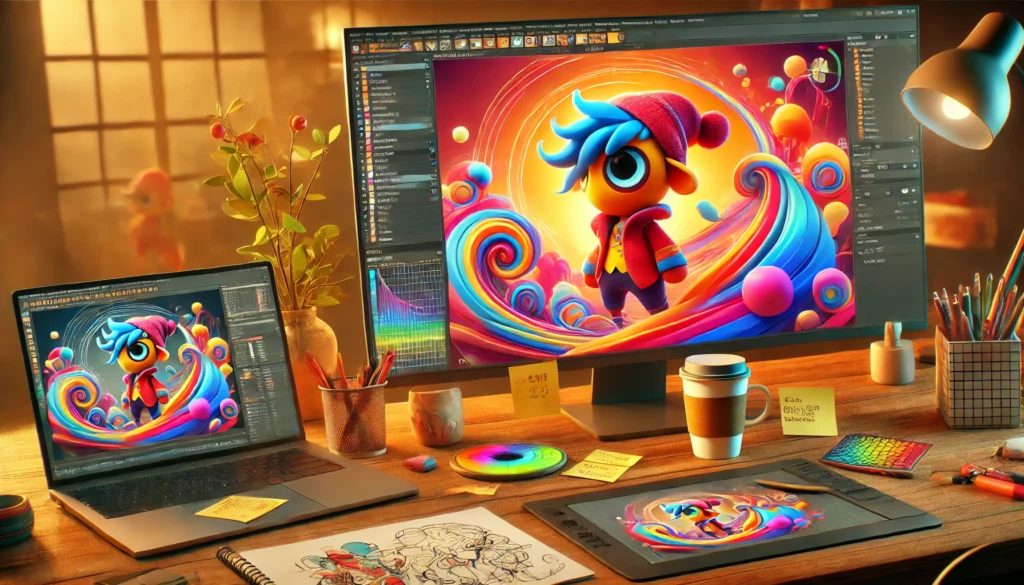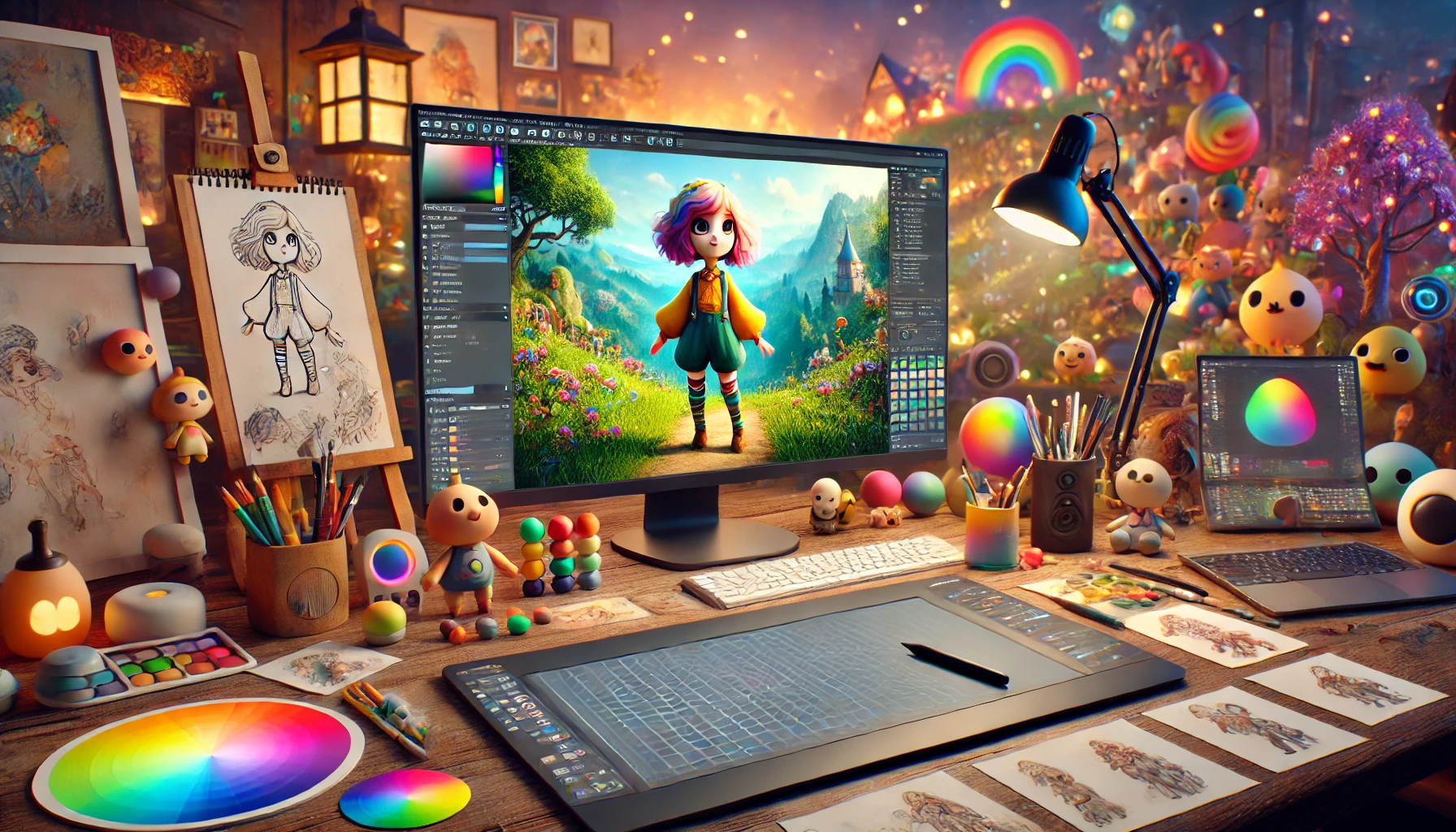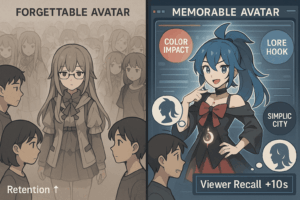Creating a stylized 3D character is not just an artistic endeavor; it’s a journey into a world where imagination meets technology, and every detail tells a story. Did you know that the global 3D animation market is projected to reach $33.78 billion by 2025, with a significant portion driven by the demand for stylized characters in films, video games, and virtual reality? This staggering growth highlights the importance of mastering the skills involved in character modeling.
Have you ever wondered how your favorite animated characters come to life, from the initial spark of an idea to the final, polished model? This blog will unveil the complete character modeling workflow, revealing the secrets behind each phase—from concept creation to rendering—that transforms a simple sketch into a vibrant, dynamic persona.
Understanding Stylized 3D Character in 3D Modeling
Stylized characters are those that deviate from realistic human or animal proportions, often exaggerating features or following a unique design style. These characters are widely used in animation, games, and advertisements due to their charm and appeal. The process and art of creating these characters requires a strong understanding of anatomy, design principles, and the software tools that bring them to life.
One of the first things to consider when creating stylized characters is the overall body shape and silhouette of the character. Unlike realistic character modeling, stylized characters often have exaggerated proportions, such as large heads, oversized eyes, or tiny limbs. The goal is to create something that feels familiar but with a unique twist, making the character stand out.
The Importance of Concept and Reference Images in Stylized Character
Before starting the modeling process, it’s crucial to have a clear concept, and reference images are key. They guide your character’s style, features, and design, helping maintain consistency and accuracy. Reference images also aid in understanding anatomy and proportions, ensuring your model aligns with the vision and fits the chosen style, whether cartoonish, fantasy, or sci-fi.
Character Modeling: From Base Mesh to Detailed Sculpt
The character modeling process begins with creating a base mesh. This simple mesh serves as the foundation for your stylized 3D character. Starting with primitive shapes, such as cubes, spheres, and cylinders, you can begin to block out the basic form of your character. At this stage, you’re not focusing on fine details but rather on getting the proportions and overall structure right.
Once you have the base mesh, you can move on to the project’ next phase: sculpting. Using tools like ZBrush or Maya, you can refine the character’s form, adding details such as muscle structure, facial features, and clothing. This phase allows you to bring out the character’s personality, making them feel more alive and unique.
In 2024, the demand for stylized 3D characters is surging across various industries. The global 3D animation market is projected to reach $41.7 billion, growing at a CAGR of 10.34% from 2020 to 2024. This trend indicates a robust interest in unique character designs that resonate with audiences.
Texturing: Adding Life with Substance Painter
Once the character modeling is complete, the next step is texturing. Substance Painter is one of the most powerful tools for this process, allowing you to add base colors, fine details, and realistic textures to your stylized 3D character. Texturing involves painting on the 3D model’s surface, adding layers for skin, hair, clothes, and props, as well as details like stray hairs, freckles, and wrinkles.
The goal of texturing is to make your character look more realistic or stylized, depending on the desired result. You can also use filters and materials to enhance the final look, giving your character a more polished appearance. Remember to take into account the character’s environment and lighting, as these elements can greatly affect how your textures appear in the final render.
The Role of Marvelous Designer in Clothing and Costumes
When creating stylized characters, Marvelous Designer can be an incredibly useful tool for designing and simulating clothing and costumes. This software allows you to create 3D garments and suits that fit your character’s body perfectly. You can easily design clothes, adjust the fit, and add realistic folds and textures, all while keeping the design consistent with the character’s personality and style.
Marvelous Designer integrates well with other 3D software, allowing you to import your character model and simulate the clothes directly on the model. This process adds a layer of realism and a sense of depth to the character, making the final result more appealing and lifelike.
Optimizing the Model for Games and Animation
After the modeling, sculpting, and texturing are done, it’s time to optimize the model for its final use. Whether your stylized character is destined for a game, animation, or another project, optimization is crucial to ensure that the model runs smoothly in the final environment.
For games, low poly models are often preferred over low poly one, as they perform better in real-time rendering. By reducing unnecessary polygons while maintaining the integrity of the design, you can ensure that your character remains visually appealing while being optimized for performance. Tools like baking and LOD (Level of Detail) adjustments can help you optimize the model without compromising too much on quality.
In animation, you’ll need to pay attention to the rigging and posing of the character. A well-rigged and posing character will allow for more fluid movement and expression, making your character come to life in the final animation. You’ll also need to consider how the animation affects the character’s design, ensuring that the proportions and silhouette remain intact during the animation process.
Rendering the Final Result
Rendering is the final step in the character modeling process, where all the hard work comes together to create the finished image. Whether you’re rendering for a game, animation, or promotional material, the rendering stage is where you can add the finishing touches, such as lighting, shadows, props and environmental elements.
By using the right rendering techniques, you can create a compelling final image that showcases the character’s design, textures, and personality. Tools like Maya, ZBrush, and Substance Painter all have rendering capabilities that allow you to create stunning visuals that highlight the details and craftsmanship of your stylized 3D character.
Adding Personality and Appeal to Your Stylized 3D Character
One of the most important aspects of creating stylized characters is imbuing them with personality. This can be achieved through their facial expressions, body language, and clothing choices. By focusing on these details, you can make your character feel more relatable and engaging to the audience.
When designing a stylized 3D character, think about the appeal of the character. What makes them unique? Do they have a quirky trait, a strong silhouette, or a memorable color palette? These elements help the character stand out and make a lasting impression. The character’s silhouette is particularly important, as a strong silhouette can communicate a lot about the character’s personality and role in the story.
The Entire Workflow of Stylized 3D Character: A Seamless Journey from Start to Finish
The entire workflow of creating a stylized 3D character is a harmonious blend of artistry and technique, divided into key phases: concept design, modeling, sculpting, texturing, rigging, and rendering. Each step builds on the last, transforming ideas into a lifelike or stylized creation. Success lies in understanding the fundamentals—proportions, anatomy, and design principles—and mastering tools like Maya, ZBrush, and Substance Painter. It’s a process that demands patience, practice, and creativity. Remember, character modeling is as much about storytelling as it is about precision. With time and effort, you can bring any character concept to life in vivid 3D form.
Top 5 Tips for Creating Compelling Stylized 3D Character
The following tips provide essential insights for designing stylized 3D characters that stand out with unique proportions, strong silhouettes, and expressive details.
Focus on Silhouette
A strong silhouette is essential in character design. It helps your character stand out and makes it easily recognizable from any angle. Keep the shapes bold and simple, ensuring that the character’s identity is clear even without details.
Use Exaggeration in Proportions
Stylized characters often thrive on exaggerated proportions. Big heads, large eyes, and small limbs can give your character a unique charm. Experiment with shapes to find the right balance of exaggeration that complements your overall style.
Pay Attention to Facial Expressions
Facial expressions can breathe life into your character. Make sure the character’s face communicates their mood and personality. Subtle details, like raised eyebrows or a crooked smile, can add a lot to their appeal.
Keep Textures Simple but Effective
While detailed textures can be tempting, stylized characters usually benefit from simplified, clean textures. Use bold colors and distinctive patterns to keep the focus on the character’s form rather than intricate surface details.
Add Personality Through Accessories
Accessories like clothing, props, or hairstyles can significantly enhance a character’s identity. Ensure that each element reflects the character’s personality or role, such as quirky hats, cool armor, or unique footwear.

Current Trends in Stylized Character Design
As 2024 unfolds, stylized characters continue to dominate:
- Diversity: Audiences demand representation across cultures and styles.
- AI Integration: AI-driven tools are revolutionizing workflows, enabling faster and more precise designs.
- Immersive Experiences: Stylized characters are now tailored for VR and AR environments.
Keep Learning and Improving
Creating stylized characters is both exciting and rewarding, but it’s a journey of continuous learning. Whether you’re a beginner or an experienced 3D artist, there’s always more to explore in techniques, tools, and workflows. Consider taking a course or tutorial to master character modeling and texturing. By learning and experimenting, you can push creative boundaries and craft unique, compelling characters. Ready to create your own? Try 3DAiLY’s hybrid AI + Artist tool for stunning, detailed characters!



